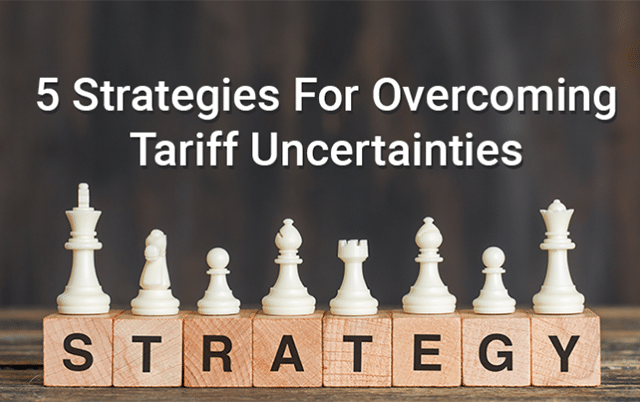5 Strategies For Overcoming Tariff Uncertainties
June 26, 2023 Supply Chain
Previous decades have faced little to no new issues in the realm of trade finances. Most trade barriers were kept well at bay through regional agreements, reduction of non-tariff barriers, and so on. However, in recent times of growing uncertainty, many such obstacles have resurfaced between previously harmonious countries. Trade has become glowingly tricky due to increased tariff and non-tariff expenses across borders which, in turn, continues to affect global economies.
To simplify things, a tariff is a form of tax levied on imported goods. The amount charged is based on the unit price of a given product. Moreover, there is no prominent trend in these fluctuating tariffs. The change in tariff values is incredibly reliant on the economic leader and exiting global climate. A great example would be China’s charge of a 25% tariff on $16 billion worth of US cargo in 2018 due to escalating bad blood between the countries.
It seems there might be no way to predict the way in which these tariffs will be influenced. However, there are specific strategies that you may employ to handle better the uncertainties that are involved:
1. Evaluate your supply chain objectively
One approach is to look at your supply chain through its constituents. Dismantling each sector and looking at it through a lens will help determine where certain costs can be predicted and even mitigated. For example, you might find it helpful to work alongside a freight forwarder to find the lacking in your shipping and distribution channels. Alternatively, you may find it useful to work alongside a customs broker to understand better cross-border shipping norms, changes in protocols, or any other way to evaluate tariffs.
2. Relocate your production
Repurposing the source of production of certain goods is another way to increase tariff reliability. Understanding the industrial potential and trends of the countries that your business associates with is crucial in building healthy tariff relations. For example, when importing a commodity from country A at a particular tariff, you might want to keep track of their economic growth. When the industry for commodity A starts to shift, you might want to relocate your import of commodity A to a different economy to avoid tariff inflation for that commodity. This strategy was quite evident in the shift of US footwear imports (via FDRA) to Vietnam in recent years.
3. Anticipate tariffs during production
It is possible to gauge the probable direction that the tariff of a product will take during its production phase itself. However, this requires much expertise and critical analysis. Nevertheless, making a few adjustments to the product’s design process or brand nature before the import can help save on specific tariff rates. Once again, a freight forwarder can assist with the product evaluation. These changes will be subject to review; however, this is typically nothing to worry about. For example, adjusting elements of fabric, stitching, dye, etc., can qualify the product for a standard tariff bracket.
4. Plan towards duty drawback
Duty drawback is the reimbursement of Customs duties, levied taxes, and any other expense paid on imported goods that are matched with consequently exported goods. It refunds nearly 99% of all duties on imports and exports within a lifetime of five years. This concept of duty drawback can help evaluate the net amount payable on certain tariffs and, hence, anticipate the gross amount of fees payable for a given product. Companies can apply for duty drawbacks if they can provide documented proof that the imported merchandise is due to re-export or be destroyed. This leeway, moreover, provides an excellent future view of how goods may be handled to incur the least amount of tariffs.
5. Use bonded warehouses and FTZs to your advantage
Bonded warehouses hold, manufacture, and manipulate merchandise of any kind that may be subjected to duty expenses. These storages are typically managed by the state/government and withdrawn after full payment of duty. To use them strategically, it is possible to store merchandise that will incur significant tariffs in bonded warehouses for up to five years without any additional expense. Similarly, Foreign Trade Zones (FTZs) can also be used to store high-tariff goods for a given period of time without additional or immediate costs. FTZs allow processing, manufacture, assembly, and re-export of the stored goods as well.


